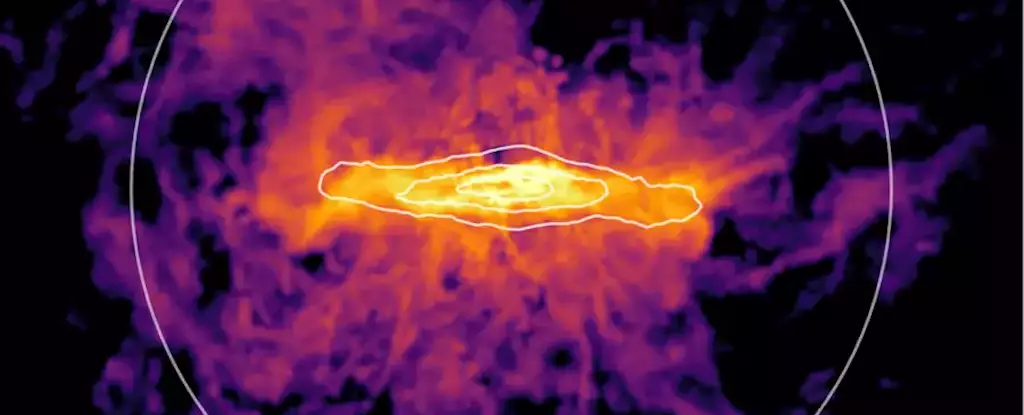Carl Sagan’s poetic declaration that “we are made of star-stuff” captures the awe-inspiring connection between the cosmos and human life. Yet, the journey of this star-stuff, particularly carbon, is far more intricate than a simple narrative of creation and formation. Recent research utilizing the Hubble Space Telescope has unveiled astonishing insights into how carbon—the very element critical to life on Earth—traverses vast distances, traveling far beyond the boundaries of our galaxy before ultimately finding its way back to us.
Stars are the cosmic foundries forging heavier elements in their fiery cores through nuclear fusion processes. Upon exhausting their nuclear fuel, these stellar giants often meet catastrophic ends, exploding into supernovae. These cataclysmic events scatter previously formed elements, like carbon, into the interstellar medium. This material does not merely float indefinitely but instead enters a larger system known as the circumgalactic medium (CGM), which envelops galaxies like a protective cocoon. This significant reservoir of gas and dust plays a crucial role in the lifecycle of galaxies, potentially fueling further star formation.
Carbon’s Wandering Journey
Intriguingly, the latest findings suggest that carbon can escape the confines of its home galaxy entirely. Researchers, led by astronomer Jessica Werk from the University of Washington, have determined that carbon can wander more than 391,000 light-years from its galaxy of origin—a distance that is astonishing when considering that the Milky Way’s disk itself is roughly 100,000 light-years wide. Carbon—or rather, star-stuff—can be thought of as a cosmic vagabond.
This study underscores the essential role of the CGM as a cosmic “train station,” as Samantha Garza aptly describes it, where elements are both emitted and subsequently reabsorbed by galaxies. The heavy elements expelled into the CGM during stellar explosions enrich this medium, allowing the ingredients for new stars and planets to be recycled through these celestial ecosystems.
The discovery of carbon in the CGM emerged from meticulous analysis using Hubble’s Cosmic Origins Spectrograph. By examining the light emitted from nine distant quasars, the research team could parse out the distinct wavelengths absorbed by carbon. This methodology not only confirms the presence of carbon at an impressive mass of three million solar masses but also highlights the importance of cooler elements within the otherwise hot plasma of ionized gases typically observed in the CGM. Previous findings had identified dynamic exchanges involving predominantly hot oxygen but failed to address the fates of cooler elements like carbon.
This nuanced understanding of carbon’s mobilization reveals that star-forming galaxies exhibit more vigorous recycling processes than their passive counterparts. We can thus infer a more complex ecological interplay within galaxies where material is continuously cycled in and out, showcasing the CGM as a vital reservoir for the sustenance of ongoing star formation.
The implications of this research extend beyond mere curiosity. The behavior of carbon and other elements within the CGM could elucidate how galaxies evolve over cosmological timescales. For instance, understanding when and why galaxies enter periods of enhanced star formation could offer critical insights into how cosmic environments respond to inevitable encounters, such as galactic mergers.
In fact, our own Milky Way is anticipated to collide with the Andromeda Galaxy, and studying how the CGM reacts in such scenarios will enable astronomers to better predict the outcomes of these cosmic dance-offs.
As we contemplate the origins of the carbon found in our bodies, we must appreciate the extensive voyages they have embarked upon. Having ventured through the vast expanse of intergalactic space, they eventually took part in the chaotic processes of galactic dynamics, emerging as fundamental building blocks of life on Earth.
The journey of the star-stuff that comprises us—its time spent drifting through the cosmos—echoes the philosophical assertion that our existence is intimately linked to the universe itself. Sagan’s words resonate deeply, emphasizing not only humanity’s cosmic heritage but also that our very essence has undergone magnificent travels before assuming its present form in our bodies. Ultimately, we are not merely inhabitants of Earth; we are, intrinsically, elements of the universe, curated by the grand laws of cosmic recycling.


Leave a Reply